After 210 days in Cuba, Katherine and I are once again back in Canada. Yesterday Katherine, Dania and I landed at Pearson after an early flight. I was shocked at the movies available to watch on the plane. Clearly I've missed many a good film and have some catching up to do. Dania (pictured below with Kat and I) works at FLACSO (la Facultad Latinoamericana de Ciencias Sociales – The Latin American Social Science Faculty).
Kat and I have been periodically meeting with Dania, Amilkar, Yudlema and Reynaldo to talk about the work we've been doing on the organopónico. Dania is coming out to spend four months in Halifax so if we're ever homesick for Cuba we can always spend some time with her.
After going through baggage claim and saying goodbye to Katherine as she went off to catch her connecting flight I was met at the airport by my parents. I can't full explain how I feel, it's a combination of heartbreak for leaving Lily, Chino and Dacio, happiness for being home with my family and friends, excitement to get back out to the east coast again, and of course I feel strange to be without Katherine who I've lived, travelled, and worked with for the past 8 months.
Looking back on the past 8 months there are many people I have to thank. Marian and Dr. Cameron at Dalhousie University for all their work preparing Katherine and I for the internship, and for providing support whenever we needed it. I'd also like to thank Dania, Amilkar, Yudlema and Reynaldo at FLACSO for meeting and talking with us throughout the summer.
Words cannot express how much love and gratitude I have for Lily, Chino and Dacio. They truly made us feel at home, feel safe and feel like family. I can't imagine Cuba without them, and know I will constantly miss them until I'm back in Cuba.
At the organopónico, I have to thank Medardo for organizing us, and for providing us with direction, and answers to our questions. Miguel and Isis Salcines (pictured below) I have to thank for their consistent concern for our happiness, and Isis, I can't wait to see you when you come to Toronto!
We met too many wonderful people for me to thank individually on the organopónico, but I do have to say that I have never before worked with more helpful, kind, or entertaining people. Below are some of the photos we took on our last day of work. I don't know when I'm going back to Cuba, but one thing is for sure, when I do go back, the organopónico will be one of the first stops on my list. Below are a couple photos from our last day of work.
Last but most certainly not least, I have to thank Katherine for putting up with all my craziness for the past 8 months. I know there are very few people I could have done this trip with. I think most weeks we were apart for a maximum of 12 hours. We lived in the same room, ate more or less every meal together, worked together, traveled together, and miraculously, at the end of all that, I still adore her. Kat, it's going to be a weird 5 days not seeing you, but at least this means we'll have new stories to tell when we next see each other. My darling friend, thank you for everything.
I'm not sure when my next post will, so this blog will in all likelihood be quiet for a while. Posting under the title "A Canadian in Cuba" does seem a little disingenuous anyway as I am now "A Canadian in Canada". Disingenuous as it may be, I will post an update or two when Katherine and I do our public engagement activity with the three SFD interns that were in Uganda.
Lastly, I have to thank you, whoever you are, for reading this blog and taking an interest in what Kat and I have been doing. I'll miss you too.
Hasta luego,
Sarah Cole.


























































